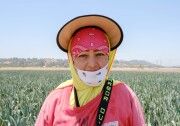Why Does It Get So Hot In Los Angeles?

The season of heat has finally arrived which means you may soon be sweating in front of your air conditioner and wondering: why does Los Angeles get so hot?
'Tis the season
A few factors ramp up the heat as the summer months trundle along.
As the weather starts to warm, ocean temperatures rise and the June Gloom melts away, leaving us without a consistent marine layer to deflect sunlight from our neighborhoods. The increase in solar radiation, which also comes with the longer days, heats things up.
Around this time of year, high pressure systems start to set up over the region as well, acting like domes, both trapping in heat and blocking cool air from flowing over us and providing relief. They’re responsible for the more extreme heat waves we experience.

Geographical conditions also play a major role, especially in places like Woodland Hills in the San Fernando Valley, which is regularly one of the hottest spots in the city.
While people along the coast benefit from both the marine layer and cool ocean air, the Santa Monica Mountains can prevent the coastal breeze from moving inland. Meaning, the hot air gets trapped in the gigantic bowl that is the Valley and just sits there.
Concrete, asphalt and black-tiled roofs also absorb heat and radiate it back out into the atmosphere in what’s known as the urban heat island effect.
Compared to rural areas, temperatures can be as much as six degrees higher during the day and 22 degrees hotter at night, making it harder for us to cool off. This impact is often more pronounced in low-income communities and communities of color for a variety of reasons such as having less tree cover to cool things down.
-
At magnitude 7.2, buildings collapsed
-
Now spinning in front of Santa Monica apartments
-
Advocates seek end to new LAUSD location policy
Then comes fire weather
After we’ve been cooking for several months under high pressure conditions and all our fuels are nice and crispy, the blustery Santa Ana winds flow in from over the Great Basin.
They pick up speed, dry out and heat up as they charge right at the West Coast, driving up temperatures and fueling catastrophic fires.

The winds usually peak in December, which isn’t a problem if the rainy season arrives on time but we’ve seen strong high pressure ridges set up off the West Coast and prevent cold and wet storms from reaching us in recent years. When this happens, dry and hot conditions can extend into winter.
The future of heat in LA
The intensity and length of heat waves is likely to increase as the climate continues to change, with some of the hotter parts of LA possibly seeing 30 or so additional days with temperatures above 90 degrees by 2050, according to the Los Angeles County Climate Vulnerability Assessment.
The coastal clouds that contribute to cooling also seem to be decreasing in frequency, raising concerns about what this’ll mean for communities that they help keep cool, especially given that a whole lot of people here don’t have air conditioning.
When it is quite hot, you should consider postponing outdoor activities because heat can be deadly, even for those that you might not expect. To that end, there are countless workers who have to choose between working in deadly conditions or potentially losing out on a paycheck partly because of a lack of adequate worker heat protections in California.
-
The state's parks department is working with stakeholders, including the military, to rebuild the San Onofre road, but no timeline has been given.
-
Built in 1951, the glass-walled chapel is one of L.A.’s few national historic landmarks. This isn’t the first time it has been damaged by landslides.
-
The climate crisis is destabilizing cliffs and making landslides more likely, an expert says.
-
Lifei Huang, 22, went missing near Mt. Baldy on Feb. 4 as the first of two atmospheric rivers was bearing down on the region.
-
Since 2021, volunteers have been planting Joshua tree seedlings in the Mojave Desert burn scar. The next session is slated for later this Spring, according to the National Park Service. Just like previous times, a few camels will be tagging along.
-
There are three main meteorological reasons why L.A. is so smoggy — all of which are affected when a rainstorm passes through and brings clearer skies.









